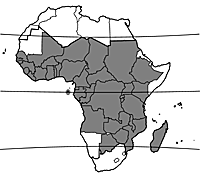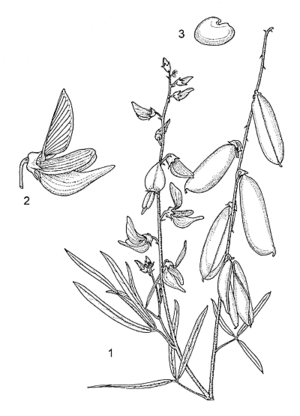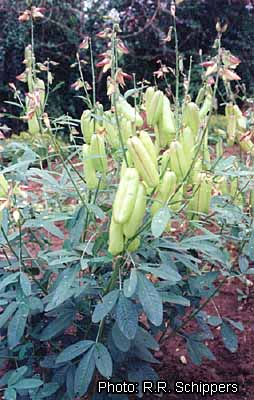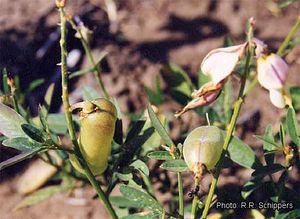Crotalaria ochroleuca (PROTA)
Introduction |
| General importance | |
| Geographic coverage Africa | |
| Geographic coverage World | |
| Vegetable | |
| Medicinal | |
| Forage / feed | |
| Food security | |
Crotalaria ochroleuca G.Don
- Protologue: Gen. hist. 2: 138 (1832).
- Family: Papilionaceae (Leguminosae - Papilionoideae, Fabaceae)
- Chromosome number: 2n = 16
Synonyms
- Crotalaria cannabina Schweinf. ex Baker f. (1914),
- Crotalaria intermedia auct. non Kotschy.
Vernacular names
- Rattlepod, rattlebox (En).
- Crotalaire, sonnette (Fr).
- Marejea (Sw).
Origin and geographic distribution
Crotalaria ochroleuca is found almost throughout tropical Africa except the north-eastern and most southern parts and most islands of the Indian Ocean. Outside Africa, it has become naturalized in Brazil, the United States (Florida), Australia, New Guinea and China. It is used as a wild or cultivated vegetable in several African countries: Senegal, Nigeria, Cameroon, Congo, DR Congo, southern Sudan, western Kenya, Uganda and north-western Tanzania.
Uses
Rattlepod is used as a leafy vegetable in Kenya and Tanzania, where it is known as ‘marejea’ or ‘mitoo’ and in Uganda, where it is called ‘alaju’. The young shoots are harvested, but towards the end of the season also individual leaves are collected. These are chopped, boiled and eaten with the staple food maize, beans or sorghum. In Uganda people may add sesame (Sesamum radiatum Schumach. & Thonn.) or groundnut paste. Due to its slightly bitter taste, most people cook it with other vegetables such as amaranth, cowpea or pumpkin leaves, or alternatively with milk. Some tribes also consume young pods and flowers in soups, but people are careful about the latter use since drowsiness occurs when flowers are eaten in quantity. Dried flowers retain their special flavour a long time and are used as a condiment for soups.
Rattlepod is used as livestock fodder and seeds are fed to poultry. Care should be taken not to use too much because the seeds contain slow-acting pyrrolizidine alkaloids that may cause damage to lungs and liver. Crotalaria ochroleuca has the capacity to fix atmospheric nitrogen by bacteria in the root nodules. Like the common sunnhemp (Crotalaria juncea L.) it is used as a green manure in crops or fallows, but this use is rare. In Sudan its fibre is used to make nets. A recent use for rattlepod is as an agent to promote the germination of Striga, a parasitic plant that is a major concern for maize and millet growers in Africa. In the presence of Crotalaria, Striga germinates and it will subsequently die due to the lack of a suitable host plant. Crotalaria ochroleuca is also known to suppress Meloidogyne root-knot nematode populations and is locally used by East African farmers either in crop rotations or as a companion crop with nematode-susceptible vegetables such as tomatoes. The leaves are used by the Tiv people in Nigeria as a treatment for yellow fever. In Sierra Leone they are applied to sore feet. Oil extracted from the seeds is insect repellent.
Production and international trade
Few statistical data are available. In Kenya and Uganda the cultivated area is approximately 3000–5000 ha, mainly as a home garden crop. All trade is through local or regional markets and international trade is limited to local cross-border trade.
Properties
The composition of Crotalaria ochroleuca per 100 g edible portion is: water 74.5 g, protein 8.8 g, Ca 222 mg, Fe 0.8 mg (Leung, W.-T.W., Busson, F. & Jardin, C., 1968). The composition is comparable to other dark green leaf vegetables, except that the dry matter content is higher than average. Analyses in Kenya gave per 100 g fresh weight: protein 4.2–4.9 g, Ca 270 mg, Fe 4 mg, β-carotene 2.9–8.7 mg, ascorbic acid 115–129 mg (Schippers, R.R., 2000). The bitterness in the leaves is caused by the presence of toxins such as pyrrolizidine alkaloids, diterpenes and phenolic compounds.
Adulterations and substitutes
Crotalaria ochroleuca can be replaced in dishes by the more bitter tasting Crotalaria brevidens Benth., which is especially liked by elderly people, or other Crotalaria species. As mulch plant and green manure, it can be replaced by Crotalaria juncea.
Description
- Erect much-branched annual or short-lived perennial herb up to 2.5 m tall; branches ascending, with short appressed hairs.
- Leaves alternate, 3-foliolate; stipules absent; petiole 1–6.5 cm long; leaflets linear to lanceolate or elliptical-lanceolate, 5–13(–18) cm × 0.5–3 cm, appressed puberulous below.
- Inflorescence a terminal raceme up to 50 cm long, many-flowered; bracts linear to subulate, 2–4 mm long.
- Flowers bisexual, zygomorphic, 5-merous; calyx 6–8 mm long, becoming truncate at base, deflexed against the pedicel, glabrous, lobes usually shorter than tube; corolla creamish or pale yellow, with ovate standard veined reddish or maroon, wings usually shorter than keel, keel with a long beak, up to 2(–2.3) cm long; stamens 10, all joined in a sheath open at base; ovary superior, 1-celled, style curved, stigma small.
- Fruit a broadly cylindrical pod (4–)5–7 cm × (1–)1.5–2 cm, appressed puberulous, black when dry, many-seeded.
- Seeds oblique-cordiform, c. 3.5 mm long, smooth, pale yellow to orange.
Other botanical information
Crotalaria comprises about 600 species and occurs throughout the tropics. Africa is by far richest with approximately 500 species. Besides the cultivated Crotalaria ochroleuca, Crotalaria brevidens and Crotalaria natalitia Meisn., several wild Crotalaria species are occasionally collected as potherbs, e.g. Crotalaria anthyllopsis Welw. ex Baker, Crotalaria cephalotes Steud. ex A.Rich., Crotalaria cleomifolia Welw. ex Baker, Crotalaria florida Welw. ex Baker and Crotalaria senegalensis (Pers.) Bacle ex DC.
Crotalaria ochroleuca is closely related to Crotalaria brevidens and information cannot always be attributed to either one of them with certainty. Crotalaria ochroleuca can best be distinguished by the colour of the flower (pale yellow or creamish vs. usually bright yellow in Crotalaria brevidens), the calyx (glabrous vs. often puberulous), and the fruit diameter ((1–)1.5–2 cm vs. 0.5–1 cm).
Growth and development
The seed germinates in 3–4 days. Early growth is slow and it may take about 8 weeks until the first harvest. The plant dies after about 6 months. Crotalaria ochroleuca forms root nodules with slow-growing Bradyrhizobium bacteria.
Ecology
Crotalaria ochroleuca is mainly found in damp grassland, especially in floodplains, depressions and along edges of swamps and rivers, but also in deciduous bushland, roadsides and fields. It grows in open localities with adequate sunshine at 300–2000 m altitude. It is favoured by warm conditions, and after the crop is well established and has formed long taproots and long lateral roots, it can tolerate rather dry conditions. In East Africa Crotalaria ochroleuca has become quite rare in the wild.
Propagation and planting
The 1000-seed weight is about 5 g. Propagation is by seed, which is sown broadcast or in rows 30 cm apart at a seed rate of 4–5 kg/ha. Thinning is done 6–8 weeks after sowing to a spacing of 10–20 cm × 10–20 cm, depending on both soil fertility and moisture level. Under dry conditions, the spacing may be up to 30 cm × 30 cm. The thinned material can be used as the first harvest. When grown for a single harvest, 4–5 crops per year can be grown, but most farmers prefer to rotate rattlepod with other crops. Rattlepod as a vegetable can be grown as a sole crop or be intercropped with finger millet, maize, kenaf and a range of other crops that benefit from the nitrogen-fixing capacity and suppression of the nematode population. As a mulch crop for bananas, coffee, kenaf, maize or sweet potato, it is sown in rows in between these main crops. When grown as a fallow crop or for green manure, seed is broadcast.
Management
Despite its nitrogen-fixing capacity, rattlepod responds well to nitrogenous fertilizers. Application of farmyard manure at a rate of 20 t/ha is recommended. The crop responds well to irrigation when rainfall is inadequate, especially at the early stages.
Diseases and pests
Few diseases are a threat to rattlepod. Fusarium wilt and to a limited extent also a mosaic-like virus occur. Under very humid conditions, the whole crop may be destroyed by a disease just before flowering. The causal agent of this disease has not yet been identified; it is probably a form of downy mildew. Aphids and thrips are often observed, but rarely cause serious damage. During fruit development, pod borers may enter and interfere with seed development. The most important pod borers are Helicoverpa armigera and Maruca vitrata. The holes in the pods will allow rain to enter and destroy the seeds further through rot. Crotalaria acts as a host plant for these pod borers, which can be a serious pest of beans, tomatoes, maize and cotton. Cuscuta suaveolens Ser., a parasitic plant that forms thread-like masses of leafless branches, may choke the crop. This South American parasitic plant is spreading in the West Nile region of both Kenya and Uganda, where rattlepod is cultivated.
Harvesting
Rattlepod as a vegetable can be harvested once-over by uprooting just before flowering when the stems are about 40 cm tall and 8 weeks old. Most farmers use this method when growing rattlepod as a catch crop between other crops. Alternatively, farmers use the thinnings as a first harvest after about 6 weeks and use a ratoon system from there onwards. The ratoon system involves first plucking the main shoot at the 8-week stage and subsequent harvesting of the new side shoots. The main shoot is cut 10–15 cm above the ground, with at least 3 leaves left. New side shoots can be picked again after 2 weeks and harvesting can take place up to 15 times if there is enough rain and application of nitrogen. Towards the dry season, no further shoots develop and people may pluck the remaining leaves before abandoning the crop.
If sown as a green manure, the young crop is incorporated in the soil. For mulch, the plants are uprooted or cut at soil level and placed between the crop rows.
Yield
The yield for a once-over harvest is about 10 t/ha (1 kg/m2). A green manure crop yields about 20 t/ha fresh organic matter.
Handling after harvest
Shoots are tied in bundles to be sold fresh at the market. The product is very perishable, and is therefore expensive in cities far from the production areas. Sprinkling the leaves with water may be detrimental since they may rot. The best way to retain their quality is by cooling the product wherever feasible. Bundles should be loosely packed in bags, not tightly like most other crops. In northern Uganda, people may get a substantial income from the dried produce. Sun drying takes 3–4 days during the dry season and 6–7 days during the rainy season. The dried leaves can be stored for up to 6 months. Flowers and young pods are plucked and dried separately for use as a condiment.
Genetic resources
Crotalaria ochroleuca is not threatened as it occurs wild virtually throughout tropical Africa.
Breeding
So far rattlepod has not been paid much attention by seed companies or research stations and improved cultivars have not been released.
Prospects
Rattlepod is a promising dual-purpose crop. Besides a high nutritional value, it has great advantages such as its repulsiveness to nematodes and its nitrogen-fixing abilities. There is some concern about the chemical compounds present in this crop, making it a health hazard when consumed regularly. The toxic compounds can possibly be eliminated by breeding. Rattlepod is increasingly in demand as a traditional vegetable at the city markets.
Major references
- Abayomi, Y.A., Fadayomi, O., Babatola, J.O. & Tian, G., 2001. Evaluation of selected legume cover crops for biomass production, dry season survival and soil fertility improvement in a moist savanna location in Nigeria. Journal of Tropical Crop Science and Production 9: 615–628.
- Burkill, H.M., 1995. The useful plants of West Tropical Africa. 2nd Edition. Volume 3, Families J–L. Royal Botanic Gardens, Kew, Richmond, United Kingdom. 857 pp.
- Fischler, M., Wortmann, C.S. & Feil, B., 1999. Crotalaria (C. ochroleuca G. Don) as a green manure in maize-bean cropping systems in Uganda. Field Crops Research 61: 97–107.
- Katende, A.B., Ssegawa, P. & Birnie, A., 1999. Wild food plants and mushrooms of Uganda. Technical Handbook No 19. Regional Land Management Unit/SIDA, Nairobi, Kenya. 490 pp.
- Maundu, P.M., Ngugi, G.W. & Kabuye, C.H.S., 1999. Traditional food plants of Kenya. Kenya Resource Centre for Indigenous Knowledge (KENRIK), Nairobi, Kenya. 270 pp.
- Polhill, R.M., 1982. Crotalaria in Africa and Madagascar. A.A. Balkema, Rotterdam, Netherlands. 389 pp.
- Schippers, R.R., 2000. African indigenous vegetables. An overview of the cultivated species. Natural Resources Institute/ACP-EU Technical Centre for Agricultural and Rural Cooperation, Chatham, United Kingdom. 214 pp.
- Uiso, F.C. & Johns, T., 1996. Risk assessment of the consumption of a pyrrolizidine alkaloid containing indigenous vegetable, Crotalaria brevidens. Ecology of Food and Nutrition 35(2): 111–119.
Other references
- Kullaya, I.K., Kilasara, M. & Aune, J.B., 1998. The potential of marejea (Crotalaria ochroleuca) as green manure in maize production in the Kilimanjaro region of Tanzania. Soil Use and Management 14: 117–118.
- Leung, W.-T.W., Busson, F. & Jardin, C., 1968. Food composition table for use in Africa. FAO, Rome, Italy. 306 pp.
- Mkiwa, F.E.J., Lwoga, A.B., Mosha, R.D. & Matovelo, J.A., 1994. Antinutritional effects of Crotalaria ochroleuca (marejea) in animal feed supplements. Veterinary and Human Toxicology 36: 96–100.
- Salako, F.K., Tian, G. & Kang, B.T., 2002. Indices of root and canopy growth of leguminous cover crops in the savanna zone of Nigeria. Tropical Grasslands 36: 33–46.
- Tian, G., Kolawole, G.O., Kang, B.T. & Kirchhof, G., 2000. Nitrogen fertilizer replacement indexes of legume cover crops in the derived savanna of west Africa. Plant and Soil 224: 287–296.
- Uiso, F.C. & Johns, T., 1996. Consumption patterns and nutritional contribution of Crotalaria brevidens in Tarime District, Tanzania. Ecology of Food and Nutrition 35: 59–69.
Sources of illustration
- Polhill, R.M., 1982. Crotalaria in Africa and Madagascar. A.A. Balkema, Rotterdam, Netherlands. 389 pp.
Author(s)
- R.R. Schippers, De Boeier 7, 3742 GD Baarn, Netherlands
Correct citation of this article
Schippers, R.R., 2004. Crotalaria ochroleuca G.Don. [Internet] Record from PROTA4U. Grubben, G.J.H. & Denton, O.A. (Editors). PROTA (Plant Resources of Tropical Africa / Ressources végétales de l’Afrique tropicale), Wageningen, Netherlands.
Accessed 18 December 2024.





